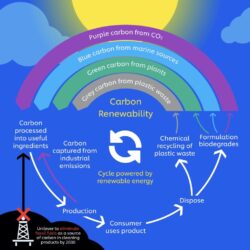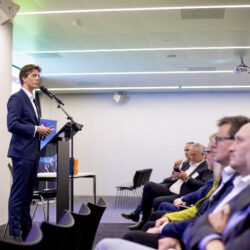Digital product passport to boost circular supply chain

As part of regulations from Brussels, every unique product in Europe will be required to have a digital product passport which contains all the information needed to reuse, repair or recycle it. During the GS1 Netherlands conference, it became clear that this product passport will lead to an explosion in supply chain data. “The circular economy still lacks a digital infrastructure. We are now trying to set that up quickly.”
By Marcel te Lindert
At the end of 2019, European Commissioner Frans Timmermans presented the Green Deal: an ambitious, comprehensive plan to improve the sustainability of the European economy. One of its components is an action plan to make today’s linear supply chains circular. This will only succeed by closing the loop for the flow of not only goods but also information. After all, a recycling company can only recycle if it knows which materials a product has been made from, and a product can only be repaired if the component parts are known.
To achieve this, the European Commission wants manufacturers to create a digital product passport for every new product in Europe in which they record what the product is made of, among other things. Information is then constantly added to the passport on the product’s journey through the supply chain, so that at the end of its lifecycle all the information needed for reuse, repair or recycling is available. “There is no question that the product passport will happen,” stated Mirjam Karmiggelt, CEO of GS1 Netherlands (pictured). She referred to the European Ecodesign for Sustainable Products Regulation which is likely to be adopted in 2024.
‘Internet of Commodities’
It is still unclear exactly what producers must record in the product passport. However, according to a preliminary list that still has to be finalized by the European Commission, it will include the name of the product and producer, the location of the factory, the origin of the materials used, the proportion of chemical and recycled materials, and instructions for use, recycling and/or disassembly.
Jan Jonker, Emeritus Professor of Sustainable Business at Radboud University, drew parallels with the Internet of Things by referring to it as the ‘Internet of Commodities’. “We are moving towards an economy in which we no longer sell products, but rather product functionalities. That requires us to start providing products with digital product passports so that they can be tracked. We want to know where those products are because they have value. We need to drive value retention.”
Standards are needed
Besides questions about what information the product passports should contain, there is still much uncertainty about the underlying technology. The European Commission has indicated that the intention is not to endlessly copy existing product data into new databases. Instead, product data should remain wherever it has been created and the passport should be linked to the relevant sources. This requires standards, Karmiggelt claimed: “We can only do this efficiently if all the systems speak the same language. If we develop different languages and constantly have to translate all the data, the costs will rise, mistakes will be made and data will be recaptured unnecessarily in a variety of Excel files.”
Standards are also needed to unlock the data from the product passport. To this end, each product must be provided with a unique identifier in the shape of a QR code which opens the product passport when scanned. “The question is whether everyone will be able to process all that data. We have to look carefully at which data a consumer needs and which data a producer needs. And then we have to agree which data we are going to share with each other at which level,” Karmiggelt continued.
Infrastructure for circular economy
Moreover, it is not yet clear how exactly the technology behind the product passport should work. There is still an intermediate step between scanning the QR code and opening the passport. Loek Boortman, CTO of GS1 Netherlands, commented: “As I said, we have identified the sources containing all the data, but something has to happen that allows us to refer to those sources after scanning the 2D barcode. After all, we want to leave that data at source rather than copying it. We don’t yet know exactly how that step should look. GS1 has been asked to think about such issues with a large number of other parties within the Cirpass consortium.”
Creating digital product passports will be a huge task. Sascha Bloemhoff, Marketing Director of Niaga, an agency that helps mattress, carpet and furniture manufacturers to set up circular business models, likened the situation to the payment system: “The circular economy still lacks a digital infrastructure. We are now trying to set that up quickly. That is like switching from a situation with cash and cheques to a situation with IBAN numbers, iDEAL (an online payment method, Ed.) and contactless payments overnight – but that transition took years.”
Battery sector has already started
At the very least, the European Commission wants to develop a digital product passport for the 30 product groups with the greatest environmental impact. For each product group, agreements must be made about the data to be included in the passport. These agreements will be laid down in so-called ‘delegated acts’. The plan is to draw up three delegated acts per year over a period of ten years, amounting to 30 in total. The first definitive product passports are expected in 2026 or 2027.
Meanwhile, the battery sector has already taken the initiative to develop a product passport to boost the reuse and recycling of batteries, and a draft version is now ready. Next in line to draw up the first delegated acts are the textile and electronics sectors, and the first discussions about this have already taken place in the textile sector. “Everyone has their own wishes,” said Michiel van Yperen, who is supervising the transition to a circular textile supply chain on behalf of MVO Nederland. “Sorting companies want garments to be tagged so they can be sorted automatically. Recycling specialists especially want to know whether the clothing has been treated with chemicals. We are now in the process of forming a ‘coalition of the willing’.”
Global issue
Karmiggelt emphasized during the GS1 conference that the digital product passport is not a Dutch issue. “This legislation comes from Europe, so we have to take it up at the European level. We are working in all sorts of ways – not only in the Netherlands, but also at the European and even global level. Because when the digital product passport goes live, all products coming into Europe must have one. So even companies that make products on the other side of the world will have to record data in a passport.”
Karmiggelt put the move into perspective for anyone who feared that this legislation could harm Europe’s position in the global economy: “Similar developments are also being worked on elsewhere. Australia is already very advanced, and China is taking steps too. In some cases, they want to know more about imported products than we do in Europe and they have made more progress than us in some respects. That’s why, within GS1, we are working on this topic with 116 of the world’s countries. The product passport is a global issue.”










